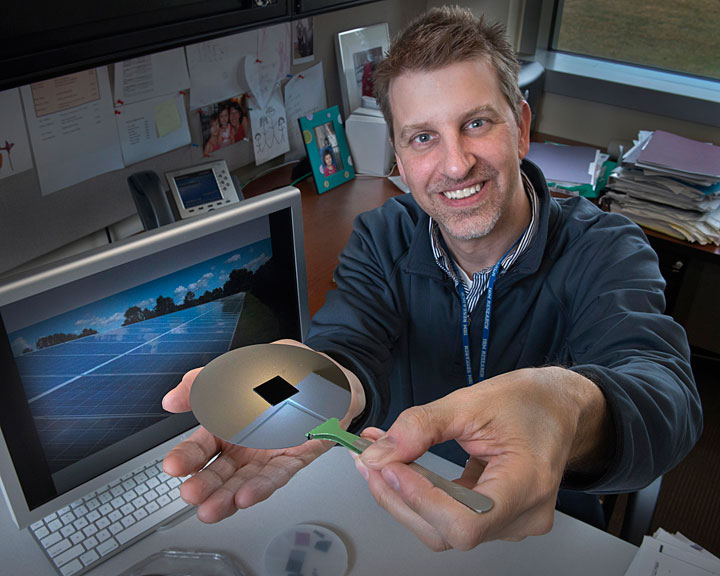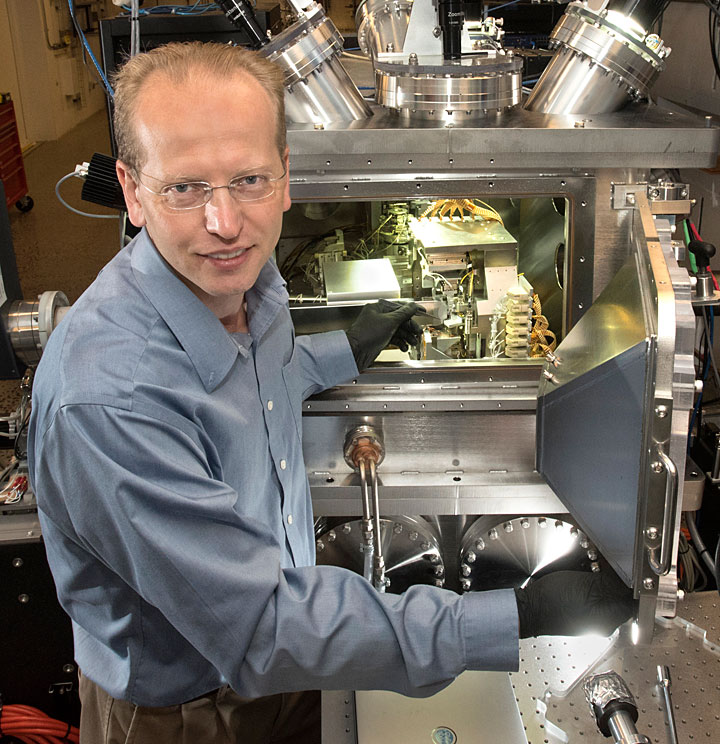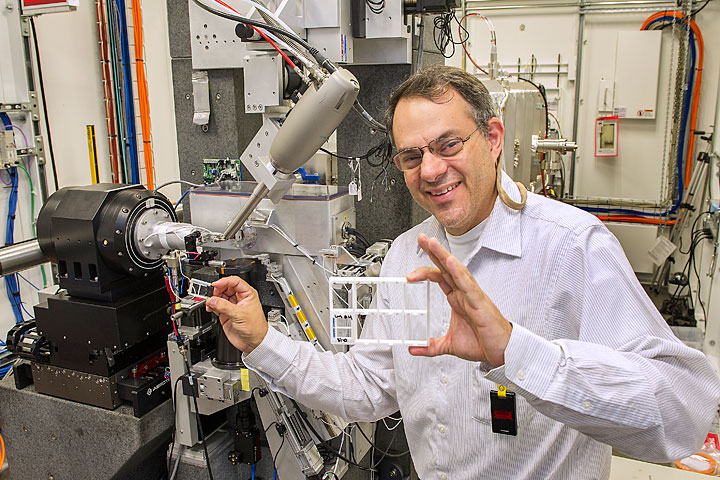Five Brookhaven Lab Projects Selected as R&D 100 Award Finalists
August 29, 2016
UPTON, NY — Five projects from the U.S. Department of Energy's (DOE) Brookhaven National Laboratory have been selected as finalists for the 2016 R&D 100 awards, which honor the top 100 proven technological advances of the past year as determined by a panel selected by R&D Magazine.
"This was a very strong year for research and development across various markets, led by many outstanding technologies that broadened the scope of innovation," said R&D Magazine Editor Anna Spiewak in a press release announcing the finalists. "We are honored to recognize these products and the project teams behind the design, development, testing, and production of these remarkable innovations and their impact in the field."
Robert Tribble, Brookhaven National Laboratory's Deputy Director for Science & Technology, added, "The Laboratory is pleased that five of our technologies have been selected as finalists for the 2016 R&D 100 awards. Our scientific mission includes translating new ideas into benefits to society. These awards recognize the important role the Lab plays in connecting research to commercial impact."
The winners will be announced on November 3, 2016, at the Gaylord National Resort & Convention Center in Oxon Hill, Maryland, near Washington, D.C.
The Brookhaven finalists are:
MoSoy Catalyst
A novel low-cost, high-performance electrocatalyst derived from biomass (soybean) and a non-precious transition metal (molybdenum) for producing hydrogen. The project was led by Brookhaven chemists James Muckerman, Etsuko Fujita, and Kotaro Sasaki with the participation of Wei-Fu Chen (former postdoctoral Research Associate) and twin sisters Shweta and Shilpa Iyer (high school summer students).
This technology delivers a durable and effective catalyst that can be used as a cathode electrode in either a solar photochemical electrolysis cell using sunlight or an electrolyzer using electricity from external sources, such as photovoltaics, to split water into hydrogen (at a cathode) and oxygen (at an anode). It eliminates the need for expensive metals such as platinum, improving the economic viability of this technology for producing hydrogen. The hydrogen can be compressed, stored and transported for use directly as a fuel or for hydrogenating carbon compounds in a process that mimics photosynthesis for producing energy-rich hydrocarbons. Read more about the MoSoy catalyst.
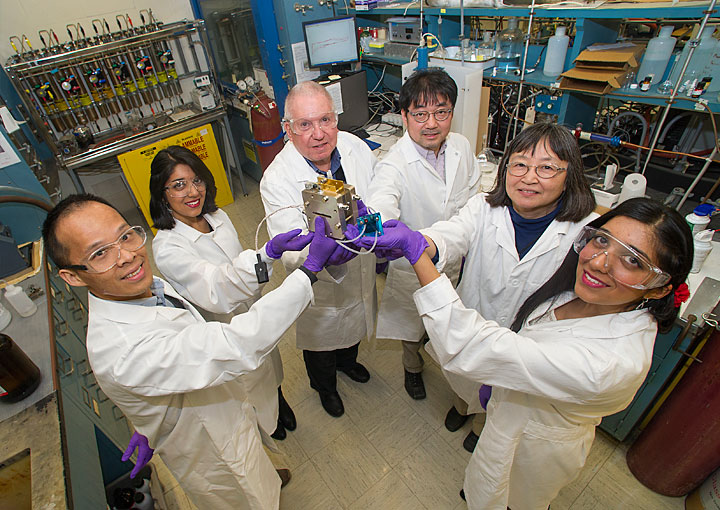 enlarge
enlarge
From left: Wei-Fu Chen, Shweta Iyer, James Muckerman, Sasaki Kotaro, Etsuko Fujita, and Shilpa Iyer
Nanostructured Anti-reflecting and Water-repellent Surface Coatings
A scalable, nanotechnology-based surface-texturing method that imparts perfect anti-reflection and robust water-repellency to silicon, glass, and some plastics. Brookhaven physicist Charles Black, recently named Director of the Lab's Center for Functional Nanomaterials (CFN), led this project.
This work leverages the ability of materials called block copolymers to self-assemble into ordered patterns with dimensions measuring tens of nanometers. The scientists use these self-assembled nanoscale patterns as templates for etching the surface of silicon, glass, or plastic. The resulting nanotextured surfaces have remarkable properties: the ability to absorb all wavelengths of light from any angle and robust water repellency (with water droplets carrying away particles of dirt). The technology could potentially be used to produce highly efficient, self-cleaning solar cells, glare-free cell phone screens, and perfectly transparent windows. Read more about the antireflective and water repellent results.
Hard X-ray Scanning Microscope with Multilayer Laue Lens Nanofocusing Optics
A high-throughput hard x-ray scanning microscope with specialized lenses for imaging of a broad range of materials spanning from nanoscience to biology with the spatial resolution better than 20 nanometers.
This is a joint entry with DOE's Argonne National Laboratory, led at Brookhaven by physicists Evgeny Nazaretski and Yong Chu along with their NSLS-II collaborators. This novel MLL-based vacuum-compatible microscope is a general purpose x-ray instrument suitable for a broad range of imaging experiments. Multimodality of the scanning hard x-ray microscope allows users to perform comprehensive structural and chemical studies on various material systems with sub-20 nm spatial resolution. This unique instrument has been commissioned and is available to the NSLS-II user community.
Flex Plate
A type of lab-ware to be used in protein crystallization, where the protein crystals formed within can be studied using x-ray diffraction without the need for a plate-handling robot.
The device was developed by a group led by Brookhaven biophysicist Alex Soares, who works at Brookhaven's National Synchrotron Light Source II (NSLS-II), one of the world's brightest sources of x-rays for studying protein crystals. The Flex Plate is designed to operate in connection with standard liquid handling robots for high throughput screening of crystallization conditions for crystal discovery projects or chemical libraries for drug discovery projects.
Ultra-compact Diamond X-ray Monitors
Fulfilling a universal need among synchrotron beamline developers and researchers, scientists at Brookhaven National Laboratory, Stony Brook University, and Case Western Reserve University have developed x-ray detectors based on synthetic diamond that provide extraordinarily accurate measurements of x-ray flux, position, and shape. The diamond x-ray beam position monitors developed by the team, led at Brookhaven Lab by the Instrumentation Division's John Smedley, have already begun to play a vital role in x-ray beam diagnostics, and have been installed in synchrotrons worldwide.
Significant advances in sensor and electronics readout design have resulted in many innovative applications not possible using previously available detectors. Not only have these innovations made a huge impact in enhancing scientific research conducted at synchrotrons, the capabilities of these detectors have extended their application to the medical dosimetry community. The radiation hardness, dynamic range and speed of diamond make it ideal for monitoring gamma ray, proton, and carbon ion beams for use in cancer radiotherapy. Similar diamond-based devices are already used as radiation-hard beam monitors at the Large Hadron Collider. Read more about diamond detectors.
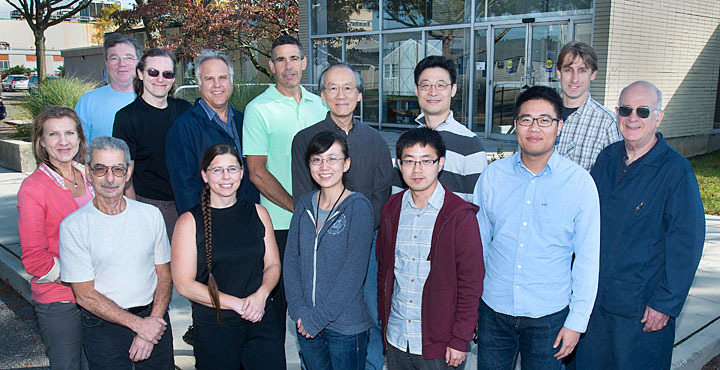 enlarge
enlarge
The diamond x-ray monitor team includes front row, left to right: Kim Ackley (Instrumentation), John Triolo (Instrumentation), Jen Bohon (Case Western Reserve project lead), Mengjia Gaowei (Instrumentation), Wenxiang "Owen" Ding (Stony Brook), Tianyi Zhou (Stony Brook), Howard Hansen (Instrumentation). Back, left to right: John Walsh (Instrumentation), John Smedley (Instrumentation, Brookhaven project lead), Ron Angona (Instrumentation), Don Pinelli (Instrumentation), Albert Lum (Instrumentation), Ming Lu (Center for Functional Nanomaterials), Erik Muller (Stony Brook University lead). Not pictured: Gianluigi De Geronimo (Instrumentation), Jack Fried (Instrumentation), Don Abel (Case Western).
The R&D 100 Awards
Since 1987, Brookhaven Lab has won more than 30 of the prestigious R&D 100 awards that celebrate the top 100 proven technological advances of the year as judged by R&D Magazine. These technologies include innovative new materials, chemistry breakthroughs, biomedical products, consumer items, testing equipment, and high-energy physics.
The first three of the five projects listed above were supported by the DOE Office of Science. Flex Plate was supported by the National Institutes of Health. The Ultra-compact Diamond X-Ray Monitors project was supported by the Office of Science, the National Institutes of Health and the National Science Foundation. All but the last project had additional funding from Brookhaven's internal Technology Maturation Program. NSLS-II and CFN are DOE Office of Science User Facilities.
Brookhaven National Laboratory is supported by the Office of Science of the U.S. Department of Energy. The Office of Science is the single largest supporter of basic research in the physical sciences in the United States, and is working to address some of the most pressing challenges of our time. For more information, please visit science.energy.gov.
2016-11866 | INT/EXT | Newsroom




